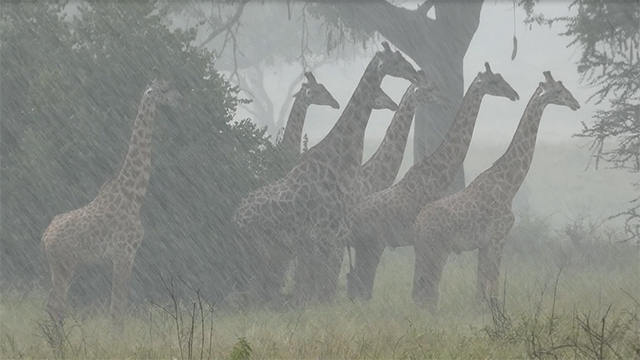Navigation auf uzh.ch
Navigation auf uzh.ch

Climate change is expected to cause widespread decline in wildlife populations worldwide. But little was previously known about the combined effects of climate change and human activity on the survival rates not only of giraffes, but of any large African herbivore species. Now researchers from the University of Zurich and Pennsylvania State University have concluded a decade-long study – the largest to date – of a giraffe population in the Tarangire region of Tanzania. The study area spanned more than a thousand square kilometers, including areas inside and outside protected areas. Contrary to expectations, higher temperatures were found to positively affect adult giraffe survival, while rainier wet seasons negatively impacted adult and calf survival.
Led by Monica Bond, a postdoctoral research associate in the Department of Evolutionary Biology and Environmental Studies at the University of Zurich, the research team quantified the effects of local anomalies of temperature, rainfall and vegetation greenness on the probability of survival of the giraffes. They also explored whether climate had a greater effect on giraffes that were also impacted by human activity at the edges of the protected reserves.
“Studying the effects of climate and human pressures on a long-lived and slow-breeding animal like a giraffe requires monitoring their populations over a lengthy time period and over a large area, enough to capture both climate variation and any immediate or delayed effects on survival,” said Bond. The team obtained nearly two decades of data on local rainfall, vegetation greenness and temperature during Tanzania’s short rains, long rains and dry season, and then followed the fates of 2,385 individually recognized giraffes of all ages and sexes over the final eight years of the two-decade period.
The team had predicted that higher temperatures would hurt adult giraffes because their very large body size might make them overheat, but in fact they found that higher temperatures positively affected adult giraffe survival. “The giraffe has several physical features that help it to keep cool, like a long neck and legs for evaporative heat loss, specialized nasal cavities, an intricate network of arteries that supply blood to the brain, and spot patches which radiate heat,” noted Derek Lee, associate research professor of biology at Pennsylvania State University and senior author of the study.
However, Lee also pointed out that “temperatures during our study period may not have exceeded the tolerable thermal range for giraffes, and an extreme heat wave in the future might reveal a threshold above which these massive animals might be harmed.”
Survival of giraffe adults and calves was reduced during rainier wet seasons, which the researchers attributed to a possible increase in parasites and disease. A previous study in the Tarangire region showed giraffe gastrointestinal parasite intensity was higher during the rainy seasons than the dry season, and heavy flooding has caused severe outbreaks of diseases known to cause mortality in giraffes, such as Rift Valley fever virus and anthrax. The current study also found higher vegetation greenness reduced adult giraffe survival, potentially because faster leaf growth reduces nutrient quality in giraffe food.
Climate effects were exacerbated by the giraffes’ proximity to the edge of protected reserves, but not during every season. “Our findings indicate that giraffes living near the peripheries of the protected areas are most vulnerable during heavy short rains. These conditions likely heighten disease risks associated with livestock, and muddy terrain hampers anti-poaching patrols, leading to increased threats to giraffe survival,” said Arpat Ozgul, University of Zurich professor and study author.
The team concluded that projected climate changes in East Africa, including heavier rainfall during the short rains, will likely threaten the existence of giraffes in one of Earth’s most important landscapes for large mammals, indicating the need for effective land-use planning and anti-poaching to improve giraffes’ resilience to the coming changes.
M.L. Bond, A. Ozgul, and D. Lee. Effect of local climate anomalies on giraffe survival. 10 June 2023. Biodiversity and Conservation. Doi: 10.1007/s10531-023-02645-4